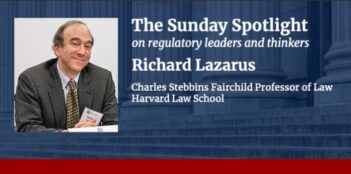
Scholars argue that state policymaking cannot effectively counteract federal environmental deregulation.
What’s red, blue, and purple all over?
The United States. America is divided into Democrat and Republican-dominated states, as well as some mixed states—blue, red, and purple states, respectively.
Two legal scholars have recently argued that the divided partisanship in the United States limits states’ abilities to enact progressive environmental regulations.
In a recent paper, Denise Grab of New York University School of Law and Michael A. Livermore of University of Virginia School of Law argue that the Trump Administration’s rollback of federal environmental regulations could hinder environmental policy at the state level as well. Grab and Livermore contend that, while blue states continue to enact policies to combat climate change and explore renewable energy sources, red and purple states have little incentive to do more than maintain the status quo.
It is no secret that the Trump Administration has been rolling back and delaying environmental regulations and policies of former administrations, such as the Obama Administration’s Clean Power Plan. But because the U.S. government has a federalist structure—a division between federal and state governments—states can enact their own policies in response to federal deregulation. For example, Virginia’s state government recently created plans to meet the requirements of the Clean Power Plan despite President Trump’s rollback of the policy.
The federalist framework in the United States can also, however, support federal deregulation. Federalism has become a unifying concept for the Trump Administration’s deregulatory agenda, with former Environmental Protection Agency (EPA) Administrator Scott Pruitt arguing that rolling back federal regulations would give states more power to regulate—or deregulate—as they see fit.
States such as California and New York continue to combat greenhouse gas emissions by enacting environmental policies at the local level. Grab and Livermore point to California’s role hosting a global climate discussion with United Nations officials and New York’s order to phase out coal plants as evidence of responsive actions. But these policies, while addressing harms in their own states, cannot directly implement or influence policies in red or purple states, argue Grab and Livermore.
Effective state policymaking requires understanding which policies are attractive to politicians in red and purple states, Grab and Livermore maintain.
Under the Obama Administration’s Clean Power Plan, for example, red and purple state policymakers were responsible for determining how to meet national emissions goals. Grab and Livermore note that during the Obama Administration, Arizona formally announced that it was initiating efforts to comply with the Clean Power Plan. Under the current Administration, however, Arizona is no longer pursuing these efforts. Without the Clean Power Plan, red and purple states lack the motive to develop environmental regulations. Grab and Livermore note that a number of other red and purple states have also scrapped their Clean Power Plan compliance efforts since the administration change.
Grab and Livermore argue that one of the benefits of federalism is the opportunity for political experimentation. State experimentation with local policies produces valuable information about what policies might be attractive to different voters of varying jurisdictions. With the Trump Administration taking steps to repeal the Clean Power Plan, contend Grab and Livermore, there are now fewer opportunities to gather information on shrewd approaches to climate change.
Although Trump-era state climate policy has mostly progressed in blue states alone, Grab and Livermore note that some red and purple states are also pushing for clean energy policies. For example, former Nevada governor Brian Sandoval (R) signed a bill that would make it cheaper for homeowners to install and use rooftop solar panels and also signed several other clean energy bills.
Why are energy policies more palatable in red and purple states than climate policies? Grab and Livermore argue that because cheap renewable energy sources are becoming widespread, conservative state legislatures are starting to view moving towards cleaner energy sources as common sense policy. Grab and Livermore point to Iowa as an example, a state where Governor Kim Reynolds (R) has “innovative energy policy” as a key platform and where thirty-six percent of electricity comes from wind energy. Similarly, in Texas—a red state—wind energy comprises fourteen percent of state electricity production, note Grab and Livermore.
Grab and Livermore hold that these examples of red and purple states enacting progressive energy policies provide insight into the types of climate policies that Republican constituencies might find acceptable. These policies could also be promulgated throughout the country in similar jurisdictions, they note.
Although moving towards cleaner energy sources has been effective in these red and purple states, Grab and Livermore acknowledge that the federal government could try to hamper state efforts to enact progressive environmental policy by forbidding states from regulating environmental issues. EPA, for example, recently proposed the revocation of California’s power to set its own emissions standards for cars. As for energy policy, power companies challenged state clean energy programs in Illinois and New York, arguing that the Federal Power Act preempts these programs.
Federalism creates opportunities for states to resist the federal environmental deregulation of the Trump Administration with progressive policies. This federalist system, however, also demonstrates a need for national regulation where a policy vacuum exists. Although blue states continue to push for climate and clean energy policy, without a federal mandate, many red and purple states have slowed their efforts. As a result, progressive legislators face an uphill battle in regulating environmental issues across the country at large.



